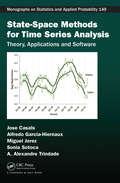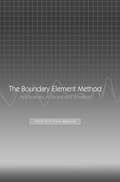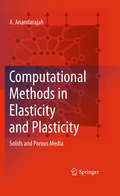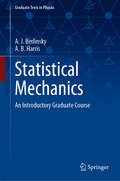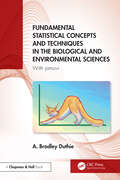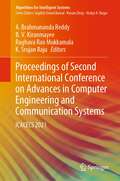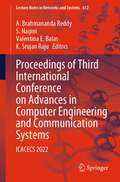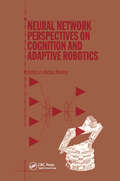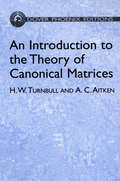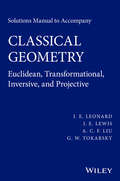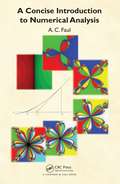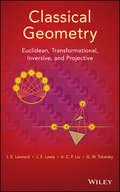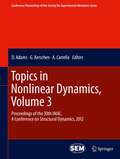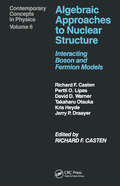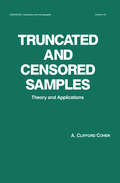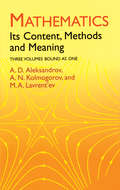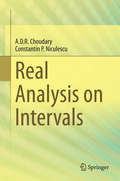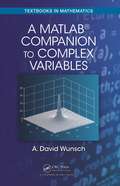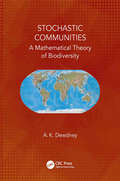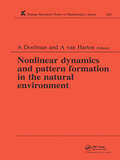- Table View
- List View
State-Space Methods for Time Series Analysis: Theory, Applications and Software (Chapman & Hall/CRC Monographs on Statistics and Applied Probability)
by Jose Casals Alfredo Garcia-Hiernaux Miguel Jerez Sonia Sotoca A. Alexandre TrindadeThe state-space approach provides a formal framework where any result or procedure developed for a basic model can be seamlessly applied to a standard formulation written in state-space form. Moreover, it can accommodate with a reasonable effort nonstandard situations, such as observation errors, aggregation constraints, or missing in-sample values. Exploring the advantages of this approach, State-Space Methods for Time Series Analysis: Theory, Applications and Software presents many computational procedures that can be applied to a previously specified linear model in state-space form. After discussing the formulation of the state-space model, the book illustrates the flexibility of the state-space representation and covers the main state estimation algorithms: filtering and smoothing. It then shows how to compute the Gaussian likelihood for unknown coefficients in the state-space matrices of a given model before introducing subspace methods and their application. It also discusses signal extraction, describes two algorithms to obtain the VARMAX matrices corresponding to any linear state-space model, and addresses several issues relating to the aggregation and disaggregation of time series. The book concludes with a cross-sectional extension to the classical state-space formulation in order to accommodate longitudinal or panel data. Missing data is a common occurrence here, and the book explains imputation procedures necessary to treat missingness in both exogenous and endogenous variables. Web ResourceThe authors’ E4 MATLAB® toolbox offers all the computational procedures, administrative and analytical functions, and related materials for time series analysis. This flexible, powerful, and free software tool enables readers to replicate the practical examples in the text and apply the procedures to their own work.
The Boundary Element Method: Applications in Sound and Vibration
by A. Ali C. RajakumarThe Boundary Element Method, or BEM, is a powerful numerical analysis tool with particular advantages over other analytical methods. With research in this area increasing rapidly and more uses for the method appearing, this timely book provides a full chronological review of all techniques that have been proposed so far, covering not only the funda
Computational Methods in Elasticity and Plasticity: Solids and Porous Media
by A. AnandarajahComputational Methods in Elasticity and Plasticity: Solids and Porous Media presents the latest developments in the area of elastic and elasto-plastic finite element modeling of solids, porous media and pressure-dependent materials and structures. The book covers the following topics in depth: the mathematical foundations of solid mechanics, the finite element method for solids and porous media, the theory of plasticity and the finite element implementation of elasto-plastic constitutive models. The book also includes: -A detailed coverage of elasticity for isotropic and anisotropic solids. -A detailed treatment of nonlinear iterative methods that could be used for nonlinear elastic and elasto-plastic analyses. -A detailed treatment of a kinematic hardening von Mises model that could be used to simulate cyclic behavior of solids. -Discussion of recent advances in the analysis of porous media and pressure-dependent materials in more detail than other books currently available. Computational Methods in Elasticity and Plasticity: Solids and Porous Media also contains problem sets, worked examples and a solutions manual for instructors.
Statistical Mechanics: An Introductory Graduate Course (Graduate Texts in Physics)
by A. J. Berlinsky A. B. HarrisIn a comprehensive treatment of Statistical Mechanics from thermodynamics through the renormalization group, this book serves as the core text for a full-year graduate course in statistical mechanics at either the Masters or Ph.D. level. Each chapter contains numerous exercises, and several chapters treat special topics which can be used as the basis for student projects. The concept of scaling is introduced early and used extensively throughout the text. At the heart of the book is an extensive treatment of mean field theory, from the simplest decoupling approach, through the density matrix formalism, to self-consistent classical and quantum field theory as well as exact solutions on the Cayley tree. Proceeding beyond mean field theory, the book discusses exact mappings involving Potts models, percolation, self-avoiding walks and quenched randomness, connecting various athermal and thermal models. Computational methods such as series expansions and Monte Carlo simulations are discussed, along with exact solutions to the 1D quantum and 2D classical Ising models. The renormalization group formalism is developed, starting from real-space RG and proceeding through a detailed treatment of Wilson’s epsilon expansion. Finally the subject of Kosterlitz-Thouless systems is introduced from a historical perspective and then treated by methods due to Anderson, Kosterlitz, Thouless and Young. Altogether, this comprehensive, up-to-date, and engaging text offers an ideal package for advanced undergraduate or graduate courses or for use in self study.
Geometric Methods in Signal and Image Analysis
by Hamid Krim A. Ben HamzaThis comprehensive guide offers a new approach for developing and implementing robust computational methodologies that uncover the key geometric and topological information from signals and images. With the help of detailed real-world examples and applications, readers will learn how to solve complex signal and image processing problems in fields ranging from remote sensing to medical imaging, bioinformatics, robotics, security, and defence. With an emphasis on intuitive and application-driven arguments, this text covers not only a range of methods in use today, but also introduces promising new developments for the future, bringing the reader up-to-date with the state of the art in signal and image analysis. Covering basic principles as well as advanced concepts and applications, and with examples and homework exercises, this is an invaluable resource for graduate students, researchers, and industry practitioners in a range of fields including signal and image processing, biomedical engineering, and computer graphics.
Fundamental Statistical Concepts and Techniques in the Biological and Environmental Sciences: With jamovi
by A. Bradley DuthieFundamental Statistical Concepts and Techniques in the Biological and Environmental Sciences: With jamovi is an introductory textbook for learning statistics. It starts with the very basics and prioritises helping the reader to develop a conceptual understanding of statistics, and apply the most fundamental statistical tools. New concepts are introduced with examples designed to be familiar to the reader, serving as a useful starting point for exploring more abstract concepts.Key Features: Designed to be accessible for students learning statistics in biological and environmental sciences. Utilizes the statistical software jamovi to explore new concepts. Prioritizes good statistical judgement over adherence to protocols. This book will be useful to students beginning their study of statistical concepts in biological and environmental sciences, whilst also acting as an insightful resource for teachers using jamovi in the classroom. Fundamental Statistical Concepts and Techniques in the Biological and Environmental Sciences: With jamovi is a valuable resource for anyone who wishes to understand and apply statistical techniques commonly used in the biological and environmental sciences.
Proceedings of Second International Conference on Advances in Computer Engineering and Communication Systems: ICACECS 2021 (Algorithms for Intelligent Systems)
by K. Srujan Raju B. V. Kiranmayee A. Brahmananda Reddy Raghava Rao MukkamalaThis book includes original, peer-reviewed research articles from International Conference on Advances in Computer Engineering and Communication Systems (ICACECS 2021), held in VNR Vignana Jyoythi Institute of Engineering and Technology (VNR VJIET), Hyderabad, Telangana, India, during 13–14 August 2021. The book focuses on “Smart Innovations in Mezzanine Technologies, Data Analytics, Networks and Communication Systems” enlargements and reviews on the advanced topics in artificial intelligence, machine learning, data mining and big data computing, knowledge engineering, semantic Web, cloud computing, Internet on Things, cybersecurity, communication systems, and distributed computing and smart systems.
Proceedings of Third International Conference on Advances in Computer Engineering and Communication Systems: ICACECS 2022 (Lecture Notes in Networks and Systems #612)
by K. Srujan Raju Valentina E. Balas A. Brahmananda Reddy S. NaginiThis book includes original, peer-reviewed research articles from International Conference on Advances in Computer Engineering and Communication Systems (ICACECS 2022), held in VNR Vignana Jyoythi Institute of Engineering and Technology (VNR VJIET), Hyderabad, Telangana, India, during August 11–12, 2022. The book focuses on “Smart Innovations in Mezzanine Technologies, Data Analytics, Networks and Communication Systems” enlargements and reviews on the advanced topics in artificial intelligence, machine learning, data mining and big data computing, knowledge engineering, semantic Web, cloud computing, Internet of Things, cybersecurity, communication systems, and distributed computing and smart systems.
Neural Network Perspectives on Cognition and Adaptive Robotics
by A. BrowneFeaturing an international team of authors, Neural Network Perspectives on Cognition and Adaptive Robotics presents several approaches to the modeling of human cognition and language using neural computing techniques. It also describes how adaptive robotic systems can be produced using neural network architectures. Covering a wide range of mainstream area and trends, each chapter provides the latest information from a different perspective.
An Introduction to the Theory of Canonical Matrices
by H. W. Turnbull A. C. AitkenThorough and self-contained, this penetrating study of the theory of canonical matrices presents a detailed consideration of all the theory's principal features. Topics include elementary transformations and bilinear and quadratic forms; canonical reduction of equivalent matrices; subgroups of the group of equivalent transformations; and rational and classical canonical forms. The final chapters explore several methods of canonical reduction, including those of unitary and orthogonal transformations. 1952 edition. Index. Appendix. Historical notes. Bibliographies. 275 problems.
Bootstrap Methods and their Application
by A. C. Davison D. V. HinkleyBootstrap methods are computer-intensive methods of statistical analysis, which use simulation to calculate standard errors, confidence intervals, and significance tests. The methods apply for any level of modelling, and so can be used for fully parametric, semiparametric, and completely nonparametric analysis. This 1997 book gives a broad and up-to-date coverage of bootstrap methods, with numerous applied examples, developed in a coherent way with the necessary theoretical basis. Applications include stratified data; finite populations; censored and missing data; linear, nonlinear, and smooth regression models; classification; time series and spatial problems. Special features of the book include: extensive discussion of significance tests and confidence intervals; material on various diagnostic methods; and methods for efficient computation, including improved Monte Carlo simulation. Each chapter includes both practical and theoretical exercises. S-Plus programs for implementing the methods described in the text are available from the supporting website.
Statistical models
by A. C. DavisonModels and likelihood are the backbone of modern statistics. This book gives an integrated development of these topics that blends theory and practice, intended for advanced undergraduate and graduate students, researchers and practitioners. Its breadth is unrivaled, with sections on survival analysis, missing data, Markov chains, Markov random fields, point processes, graphical models, simulation and Markov chain Monte Carlo, estimating functions, asymptotic approximations, local likelihood and spline regressions as well as on more standard topics such as likelihood and linear and generalized linear models. Each chapter contains a wide range of problems and exercises. Practicals in the S language designed to build computing and data analysis skills, and a library of data sets to accompany the book, are available over the Web.
Solutions Manual to Accompany Classical Geometry
by J. E. Lewis G. W. Tokarsky I. E. Leonard A. C. F. LiuSolutions Manual to accompany Classical Geometry: Euclidean, Transformational, Inversive, and Projective Written by well-known mathematical problem solvers, Classical Geometry: Euclidean, Transformational, Inversive, and Projective features up-to-date and applicable coverage of the wide spectrum of geometry and aids readers in learning the art of logical reasoning, modeling, and proof. With its reader-friendly approach, this undergraduate text features self-contained topical coverage and provides a large selection of solved exercises to aid in reader comprehension. Material in this text can be tailored for a one-, two-, or three-semester sequence.
A Concise Introduction to Numerical Analysis
by A. C. FaulThis textbook provides an accessible and concise introduction to numerical analysis for upper undergraduate and beginning graduate students from various backgrounds. It was developed from the lecture notes of four successful courses on numerical analysis taught within the MPhil of Scientific Computing at the University of Cambridge. The book is easily accessible, even to those with limited knowledge of mathematics.Students will get a concise, but thorough introduction to numerical analysis. In addition the algorithmic principles are emphasized to encourage a deeper understanding of why an algorithm is suitable, and sometimes unsuitable, for a particular problem.A Concise Introduction to Numerical Analysis strikes a balance between being mathematically comprehensive, but not overwhelming with mathematical detail. In some places where further detail was felt to be out of scope of the book, the reader is referred to further reading.The book uses MATLAB® implementations to demonstrate the workings of the method and thus MATLAB's own implementations are avoided, unless they are used as building blocks of an algorithm. In some cases the listings are printed in the book, but all are available online on the book’s page at www.crcpress.com.Most implementations are in the form of functions returning the outcome of the algorithm. Also, examples for the use of the functions are given. Exercises are included in line with the text where appropriate, and each chapter ends with a selection of revision exercises. Solutions to odd-numbered exercises are also provided on the book’s page at www.crcpress.com.This textbook is also an ideal resource for graduate students coming from other subjects who will use numerical techniques extensively in their graduate studies.
Classical Geometry
by J. E. Lewis G. W. Tokarsky I. E. Leonard A. C. LiuFeatures the classical themes of geometry with plentiful applications in mathematics, education, engineering, and scienceAccessible and reader-friendly, Classical Geometry: Euclidean, Transformational, Inversive, and Projective introduces readers to a valuable discipline that is crucial to understanding bothspatial relationships and logical reasoning. Focusing on the development of geometric intuitionwhile avoiding the axiomatic method, a problem solving approach is encouraged throughout.The book is strategically divided into three sections: Part One focuses on Euclidean geometry, which provides the foundation for the rest of the material covered throughout; Part Two discusses Euclidean transformations of the plane, as well as groups and their use in studying transformations; and Part Three covers inversive and projective geometry as natural extensions of Euclidean geometry. In addition to featuring real-world applications throughout, Classical Geometry: Euclidean, Transformational, Inversive, and Projective includes:Multiple entertaining and elegant geometry problems at the end of each section for every level of studyFully worked examples with exercises to facilitate comprehension and retentionUnique topical coverage, such as the theorems of Ceva and Menalaus and their applicationsAn approach that prepares readers for the art of logical reasoning, modeling, and proofsThe book is an excellent textbook for courses in introductory geometry, elementary geometry, modern geometry, and history of mathematics at the undergraduate level for mathematics majors, as well as for engineering and secondary education majors. The book is also ideal for anyone who would like to learn the various applications of elementary geometry.
Topics in Nonlinear Dynamics, Volume 3
by G. Kerschen A. Carrella D. AdamsTopics in Nonlinear Dynamics, Volume 3, Proceedings of the 30th IMAC, A Conference and Exposition on Structural Dynamics, 2012, the third volume of six from the Conference, brings together 26 contributions to this important area of research and engineering. The collection presents early findings and case studies on fundamental and applied aspects of Structural Dynamics, including papers on: Application of Nonlinearities: Aerospace Structures Nonlinear Dynamics Effects Under Shock Loading Application of Nonlinearities: Vibration Reduction Nonlinear Dynamics: Testing Nonlinear Dynamics: Simulation Nonlinear Dynamics: Identification Nonlinear Dynamics: Localization
Algebraic Approaches to Nuclear Structure
by A. CastenholzThis book is devoted to algebraic models and their applications. It presents a simple, but thorough, pedagogic approach, starting from the most elementary ideas and building up to the most recent results of advanced theories. The book is designed for a graduate level treatment.
Truncated and Censored Samples: Theory and Applications (Statistics: A Series of Textbooks and Monographs)
by A. Clifford CohenThis book deals with the development of methodology for the analysis of truncated and censored sample data. It is primarily intended as a handbook for practitioners who need simple and efficient methods for the analysis of incomplete sample data.
Microeconometrics
by A. Colin Cameron Pravin K. TrivediAn outstanding introduction to microeconometrics and how to do microeconometric research using Stata, this book covers topics often left out of microeconometrics textbooks and omitted from basic introductions to Stata. Cameron and Trivedi provide the most complete and up-to-date survey of microeconometric methods available in Stata. They begin by introducing simulation methods and then use them to illustrate features of the estimators and tests described in the rest of the book. They address each topic with an in-depth Stata example and demonstrate how to use Stata's programming features to implement methods for which Stata does not have a specific command. Multi/Card Deck Copy
Regression Analysis of Count Data
by A. Colin Cameron Pravin K. TrivediStudents in both social and natural sciences often seek regression methods to explain the frequency of events, such as visits to a doctor, auto accidents, or new patents awarded. This book provides the most comprehensive and up-to-date account of models and methods to interpret such data. The authors have conducted research in the field for more than twenty-five years. In this book, they combine theory and practice to make sophisticated methods of analysis accessible to researchers and practitioners working with widely different types of data and software in areas such as applied statistics, econometrics, marketing, operations research, actuarial studies, demography, biostatistics, and quantitative social sciences. The book may be used as a reference work on count models or by students seeking an authoritative overview. Complementary material in the form of data sets, template programs, and bibliographic resources can be accessed on the Internet through the authors' homepages. This second edition is an expanded and updated version of the first, with new empirical examples and more than one hundred new references added. The new material includes new theoretical topics, an updated and expanded treatment of cross-section models, coverage of bootstrap-based and simulation-based inference, expanded treatment of time series, multivariate and panel data, expanded treatment of endogenous regressors, coverage of quantile count regression, and a new chapter on Bayesian methods.
Mathematics: Its Content, Methods and Meaning (Dover Books on Mathematics)
by A. N. Kolmogorov A. D. Aleksandrov M. A. Lavrent’evThis major survey of mathematics, featuring the work of 18 outstanding Russian mathematicians and including material on both elementary and advanced levels, encompasses 20 prime subject areas in mathematics in terms of their simple origins and their subsequent sophisticated developement. As Professor Morris Kline of New York University noted, "This unique work presents the amazing panorama of mathematics proper. It is the best answer in print to what mathematics contains both on the elementary and advanced levels."Beginning with an overview and analysis of mathematics, the first of three major divisions of the book progresses to an exploration of analytic geometry, algebra, and ordinary differential equations. The second part introduces partial differential equations, along with theories of curves and surfaces, the calculus of variations, and functions of a complex variable. It furthur examines prime numbers, the theory of probability, approximations, and the role of computers in mathematics. The theory of functions of a real variable opens the final section, followed by discussions of linear algebra and nonEuclidian geometry, topology, functional analysis, and groups and other algebraic systems.Thorough, coherent explanations of each topic are further augumented by numerous illustrative figures, and every chapter concludes with a suggested reading list. Formerly issued as a three-volume set, this mathematical masterpiece is now available in a convenient and modestly priced one-volume edition, perfect for study or reference.
Real Analysis on Intervals
by A. D. R. Choudary Constantin P. NiculescuThe book targets undergraduate and postgraduate mathematics students and helps them develop a deep understanding of mathematical analysis. Designed as a first course in real analysis, it helps students learn how abstract mathematical analysis solves mathematical problems that relate to the real world. As well as providing a valuable source of inspiration for contemporary research in mathematics, the book helps students read, understand and construct mathematical proofs, develop their problem-solving abilities and comprehend the importance and frontiers of computer facilities and much more. It offers comprehensive material for both seminars and independent study for readers with a basic knowledge of calculus and linear algebra. The first nine chapters followed by the appendix on the Stieltjes integral are recommended for graduate students studying probability and statistics, while the first eight chapters followed by the appendix on dynamical systems will be of use to students of biology and environmental sciences. Chapter 10 and the appendixes are of interest to those pursuing further studies at specialized advanced levels. Exercises at the end of each section, as well as commentaries at the end of each chapter, further aid readers' understanding. The ultimate goal of the book is to raise awareness of the fine architecture of analysis and its relationship with the other fields of mathematics.
A MatLab Companion to Complex Variables (Textbooks in Mathematics #41)
by A. David WunschThis book is intended for someone learning functions of a complex variable and who enjoys using MATLAB. It will enhance the exprience of learning complex variable theory and will strengthen the knowledge of someone already trained in ths branch of advanced calculus. ABET, the accrediting board for engineering programs, makes it clear that engineering graduates must be skilled in the art of programming in a language such as MATLAB®. Supplying students with a bridge between the functions of complex variable theory and MATLAB, this supplemental text enables instructors to easily add a MATLAB component to their complex variables courses.A MATLAB® Companion to Complex Variables provides readers with a clear understanding of the utility of MATLAB in complex variable calculus. An ideal adjunct to standard texts on the functions of complex variables, the book allows professors to quickly find and assign MATLAB programming problems that will strengthen students’ knowledge of the language and concepts of complex variable theory.The book shows students how MATLAB can be a powerful learning aid in such staples of complex variable theory as conformal mapping, infinite series, contour integration, and Laplace and Fourier transforms. In addition to MATLAB programming problems, the text includes many examples in each chapter along with MATLAB code.Fractals, the most recent interesting topic involving complex variables, demands to be treated with a language such as MATLAB. This book concludes with a Coda, which is devoted entirely to this visually intriguing subject.MATLAB is not without constraints, limitations, irritations, and quirks, and there are subtleties involved in performing the calculus of complex variable theory with this language. Without knowledge of these subtleties, engineers or scientists attempting to use MATLAB for solutions of practical problems in complex variable theory suffer the risk of making major mistakes. This book serves as an early warning system about these pitfalls.
Stochastic Communities: A Mathematical Theory of Biodiversity
by A. DewdneyStochastic Communities presents a theory of biodiversity by analyzing the distribution of abundances among species in the context of a community. The basis of this theory is a distribution called the "J distribution." This distribution is a pure hyperbola and mathematically implied by the "stochastic species hypothesis" assigning equal probabilities of birth and death within the population of each species over varying periods of time. The J distribution in natural communities has strong empirical support resulting from a meta-study and strong theoretical support from a theorem that is mathematically implied by the stochastic species hypothesis.
Nonlinear Dynamics and Pattern Formation in the Natural Environment (Chapman And Hall/crc Research Notes In Mathematics Ser. #335)
by A. Van Harten A. DoelmanThis Research Note aims to provide an insight into recent developments in the theory of pattern formation. In the last decade there has been considerable progress in this field, both from a theoretical and a practical point of view. Recent mathematical developments concern the study of the nonlinear stability of systems at near-critical conditions by an appropriate system of modulation equations. The complexity of the original problem can be reduced drastically by this approximation. Moreover, it provides unifying point of view for a wide range of problems. New applications of the theory arise in a multitude of scientific areas such as hydrodynamics, reaction-diffusion problems, oceanography, meteorology, combustion, geophysical and biological morphodynamics and semi-conductors.This book is intended to show the interactions between the mathematical theory of nonlinear dynamics and the study of pattern generating phenomena in the natural environment. There is an intimate relationship between new insights in the mathematical aspects of nonlinear pattern formation and the comprehension of such phenomena. Therefore there are two partly overlapping main themes: one in which the emphasis is on generally applicable mathematical theories and techniques and one in which the phenomenology of pattern evolution in various areas is discussed.The book comprises 19 contributions by experts in the field. Although the emphasis changes considerably from paper to paper, in each contribution the same two themes are present; all the authors have aimed to achieve a suitable balance between the mathematical theory and the physical phenomena.
